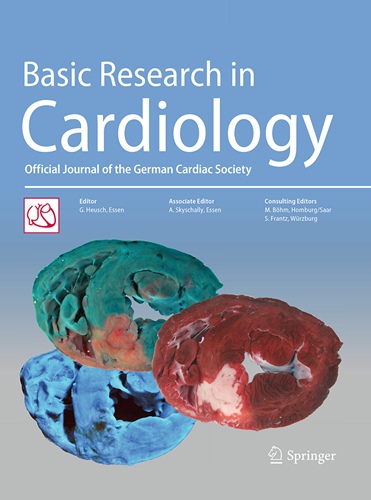在猪缺血性心脏病和运动训练模型中h2o2介导的松弛:机制见解和Kv7通道的作用
IF 8
1区 医学
Q1 CARDIAC & CARDIOVASCULAR SYSTEMS
引用次数: 0
摘要
我们之前报道过,慢性闭塞导致的h2o2介导的小动脉扩张受损可以通过运动训练得到纠正,BKCa和Kv通道都有助于这些适应。为了进一步了解受缺血和运动影响的特定Kv通道亚型,我们假设氧化还原敏感的Kv1、Kv2和Kv7通道亚家族亚型是这种运动增强通道贡献的主要末端效应器。在尤卡坦微型猪的左旋冠状动脉近端周围置入一个ameroid闭塞器,诱导缺血血管床,而由左前降支喂养的小动脉作为每只动物未闭塞的对照血管。动物被随机分配到久坐(正常的笔活动)或运动训练(跑步机;5天/周;14周)组。Kv通道是体外肌线图和电生理学研究的目标,用于功能分析,而小动脉裂解物和分离的血管平滑肌细胞用于免疫印迹和免疫荧光。我们发现冠状动脉闭塞损害了Kv7通道对h2o2介导的放松的贡献,这与运动训练相反。全细胞电压钳记录显示各组间xe991敏感电流无变化,Kv7通道蛋白无显著差异。免疫荧光分析显示,闭塞后Kv7.1通道的PKA共定位减少,运动训练后Kv7.1和Kv7.5通道的定位增加。综上所述,这些研究表明,Kv7通道从一个突出的血管松弛信号轴解偶联是由冠状动脉闭塞引起的,并在运动训练后得到恢复,这突出了该亚家族作为一个潜在的治疗靶点。本文章由计算机程序翻译,如有差异,请以英文原文为准。
H2O2-mediated relaxation in a swine model of ischemic heart disease and exercise training: mechanistic insights and the role of Kv7 channels.
We previously reported that H2O2-mediated arteriolar dilation impaired by chronic occlusion is corrected with exercise training and that BKCa and Kv channels both contribute to these adaptations. To gain additional understanding of the specific Kv channel isoforms influenced by ischemia and exercise, we hypothesized that the redox-sensitive Kv1, Kv2, and Kv7 channel subfamily isoforms would be the primary end effectors of this exercise-augmented channel contribution. Yucatan miniature swine were surgically instrumented with an ameroid occluder around the proximal left circumflex coronary artery, inducing an ischemic vascular bed, while arterioles fed by the left anterior descending artery served as nonoccluded, control vessels for each animal. Animals were randomly assigned to sedentary (normal pen activity) or exercise-trained (treadmill; 5 days/week; 14 weeks) groups. Kv channels were targeted, ex vivo, in wire myography and electrophysiology studies for functional analyses, while arteriolar lysates and isolated vascular smooth muscle cells were utilized for immunoblot and immunofluorescence. We show that coronary occlusion impairs Kv7 channel contribution to H2O2-mediated relaxation that is reversed with exercise training. Whole-cell voltage clamp recordings demonstrated no changes in XE991-sensitive currents among groups, and no significant differences in Kv7 channel protein were detected. Immunofluorescent analyses revealed a decrease in colocalization of PKA with Kv7.1 channels following occlusion and increased localization with both Kv7.1 and Kv7.5 channels following exercise training. Taken together, these studies demonstrate that Kv7 channel uncoupling from a prominent vasorelaxation signaling axis results from coronary occlusion and is restored following exercise training, highlighting this subfamily as a potential therapeutic target.
求助全文
通过发布文献求助,成功后即可免费获取论文全文。
去求助
来源期刊

Basic Research in Cardiology
医学-心血管系统
CiteScore
16.30
自引率
5.30%
发文量
54
审稿时长
6-12 weeks
期刊介绍:
Basic Research in Cardiology is an international journal for cardiovascular research. It provides a forum for original and review articles related to experimental cardiology that meet its stringent scientific standards.
Basic Research in Cardiology regularly receives articles from the fields of
- Molecular and Cellular Biology
- Biochemistry
- Biophysics
- Pharmacology
- Physiology and Pathology
- Clinical Cardiology
 求助内容:
求助内容: 应助结果提醒方式:
应助结果提醒方式:


